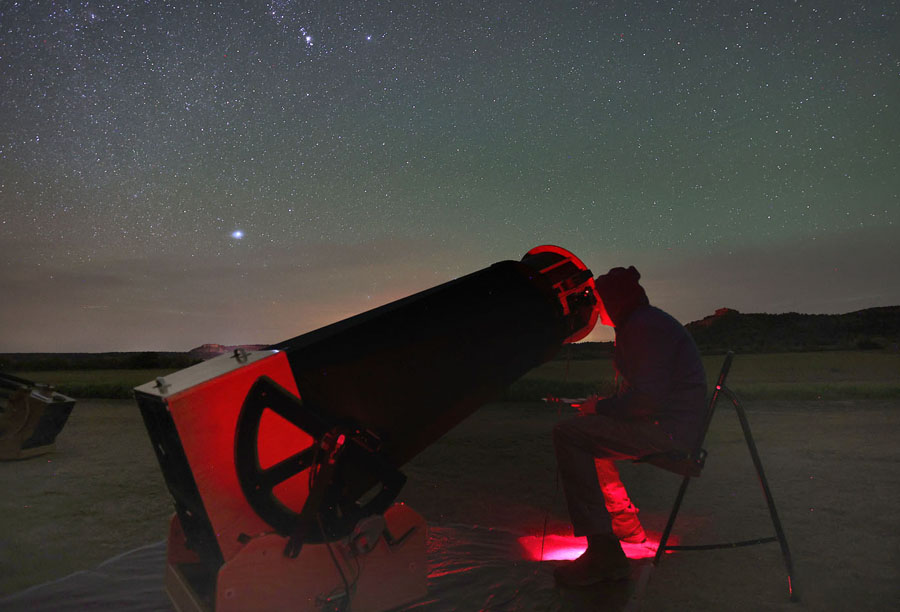ESO / Digitized Sky Survey
Road trip! Dark-sky die-hards like myself make occasional pilgrimages to pristine skies hoping to find relief from the frustrations of light pollution. Last month, a friend and I drove 1,100 miles to spend a week in the Oklahoma Panhandle with several other amateur astronomers who thirsted for darkness. We observed with telescopes and photographed to our heart’s content under a blizzard of starlight wrapped in the ribbon of the Milky Way. Several nights in, it occurred to me that the sky there would look familiar to those who inhabited these lands millennia ago before gas and then electric lighting became commonplace. Even at midnight the stars, planets, natural airglow, and the zodiacal light cast enough light to find one’s way with ease along a dirt path.

ESO
I wanted to hold on to a piece of that world so much it hurt. But there was no time to dally. Scopes were up long before sunset and by dusk were ready for their handlers. I used a 15-inch Dob. Most nights were clear or partly cloudy. Here at 37° north latitude, 10° south of home, the southern sky revealed a host of new deep-sky wonders like fossils exposed after a flood. I got down on my knees — what one does when piloting a larger Dobsonian telescope in negative declination territory — and revisited clusters and nebulae in Sagittarius, then headed straight for the aptly-named Spare Tire Nebula (IC 5148) in Grus. This 2′-wide, fainter version of the Ring Nebula (M57) glows at 11th magnitude. At 64x with an OIII filter we easily saw the ring’s north-south elongation and prominent dark hole with direct vision. After noticing its out-of-round shape, one of the visual observers quipped he’d “never drive on that thing.”

ESO / Digitized Sky Survey 2
I observed a lot of deep southern fare like NGC 300 (Southern Pinwheel), the Grus Quartet and the remarkable String of Pearls Galaxy (NGC 55) but lingered on two large, low surface brightness companions to the Milky Way — the Sculptor and Fornax dwarf galaxies, situated in Sculptor and Fornax, respectively. Both are dwarf spheroidal galaxies and located at a declination of about 34° south. From my home they culminate at 9° altitude, making them difficult targets at best. Here they climbed to nearly 20° high and were much more accessible.

MegaStar, courtesy of Emil Bonanno
Telescopic observers know that it can sometimes take a half-hour or longer to confirm seeing a faint, diffuse target. You try everything — averted vision, switching up magnification, tapping the telescope, double-checking maps and photos, refocusing, sweeping back and forth across the field of view and even yoga-like breathing exercises. If none of these works, it’s OK. You can walk away with head held high and try again another time. I think I set a new record with the Sculptor Dwarf Galaxy. Confirmation required four nights of observation!

Bob King
While its overall magnitude is 10, the galaxy’s soft light is spread over 30′ x 18′, yielding a surface brightness of 16.9. I strongly suspected it on several occasions but was only convinced on the final night after my observing eye had fully marinated. Either that or my brain had surreptitiously performed a 4-day-long mental stack! Sweeping back and forth was the key, which maximized the power of the eye’s rod cells to detect an object through movement. What I saw wasn’t much — a smooth, extremely faint, luminous presence slightly brighter than the sky background with a suggestion of a brighter center — but enough to put a smile on my face.
I suspected it would have been easier to see with a smaller instrument sporting a much wider field of view (mine was 1.1° ), the better to frame the galaxy in an oversize pool of dark sky. A 6-inch or 8-inch scope with a 2° or larger purview would be ideal for the task.

MegaStar, courtesy of Emil Bonanno
I first observed and described the four accessible globular clusters in the Fornax Dwarf in 2017 when I found them one exceptionally clear night with the 15-inch from northern Minnesota. I didn’t observe the galaxy itself then, nor did I succeed this time. Despite an overall magnitude of 8.0 (surface brightness 15.6) it’s even larger than Sculptor with dimensions of 35′ x 30′. Again, a smaller, wide-field instrument likely would have been the ticket. But it was a joy to return and reobserve the remote clusters in more detail through better air.

NASA / ESA / S. Larsen (Radboud Univ. of Netherlands)
NGC 1049, the brightest at magnitude 12.6 and 0.8′ in diameter, clearly showed structure at 142x and 286x with a small, brighter, non-stellar core embedded in a fuzzy ruff of nebulosity. The others were smaller and fainter although both Fornax 5 and Fornax 4 possessed a central brightening. Fornax 5 (mag. 13.4, diameter 1.7′) was the next easiest followed by Fornax 4 (13.9 mag., 0.8′) and Fornax 2 (13.5 mag., 0.8′). The last appeared largest but was also more diffuse and visually the faintest.

Bob King
I could go on and on about other amazing sights we saw those dark nights including the radiance of the zodiacal light (above). While grateful for it all, I’m already thirsty again.


